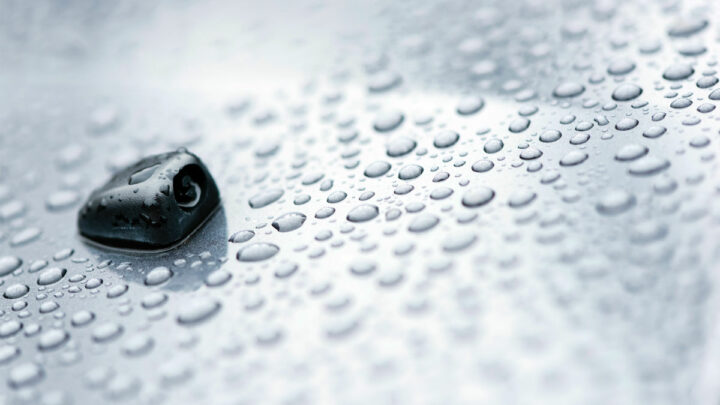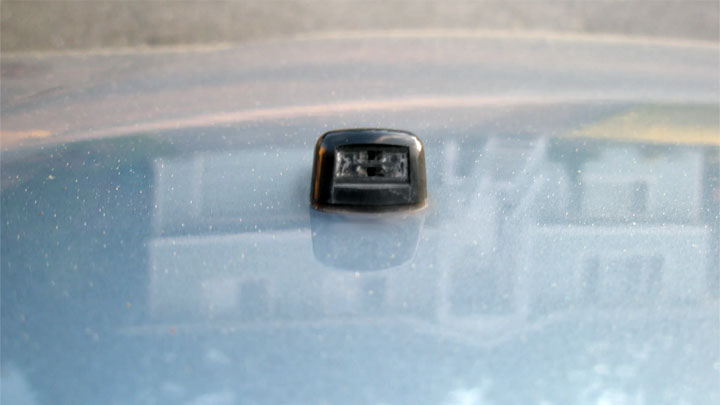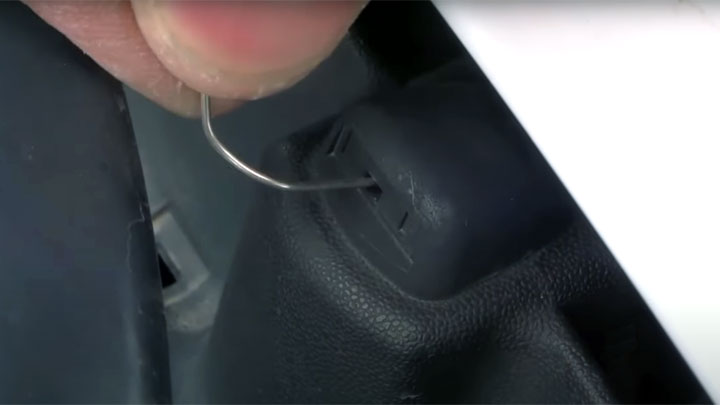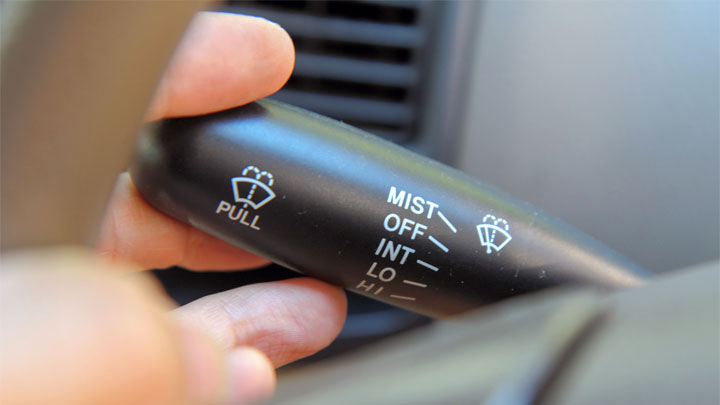Why Is My Windshield Washer Fluid Not Coming Out?
You turn on your windshield wipers during a sudden downpour only to find the blades smearing dirt and grime across your field of vision. No matter how many times you hit that wash button, no fluid comes out!
Before you resort to sticking your head out the window to see the road, continue reading to discover the most common reasons your washer fluid isn’t spraying out and how to fix it so you’re not in the same situation next time.
We’ll also let you know the one reason where professional help may be necessary.

See Also: How to Stop Squeaky Wiper Blades
Reasons Your Washer Fluid Isn’t Spraying
There are a number of potential reasons that your vehicle’s windshield washer system is failing to perform as expected, some of which are slightly more difficult to pinpoint than others. The first step to troubleshooting involves learning to identify the potential causes of windshield washer failure.
Here are the most common reasons that your vehicle’s washer fluid isn’t spraying.
#1 – Clogged Washer Nozzles
If your washer fluid nozzles are clogged, any washer fluid pumped through the system itself will be prevented from being dispersed upon the windshield. This can occur in just a single nozzle, or in both simultaneously.
#2 – Pinched Washer Fluid Hose
Any pinch point within a vehicle’s washer fluid hoses can cause a restriction, thereby preventing washer fluid from being sprayed as it otherwise would. Issues of this type are especially common in any situation where a vehicle’s wiper arms have recently been raised or manipulated.
#3 – Faulty Washer Fluid Pump
Like any electrical motor or pump, a vehicle’s washer fluid pump is prone to failure from normal wear and tear, with age. This pump can become noticeably weak, or can fail to function at all, with little in the way of warning.
Luckily, replacement costs associated with washer fluid pumps tend to be fairly reasonable.
#4 – Cracked Washer Fluid Reservoir
Most washer fluid reservoirs are constructed of plastic, making them prone to cracking and/or busting. The most common scenario is incorrect washer fluid being used during the winter months, thereby allowing freezing of the fluid to take place.
Likewise, strikes from road debris and even some fender benders can do similar damage.
Read Also: Why Won’t My Windshield Wipers Turn Off?
How to Fix

The following steps can be used to assist you in diagnosing and repairing washer fluid system related failures.
Step 1 – Inspect All System Components
Begin the diagnostic process by checking for any signs of damage or other irregularities, related to any washer fluid system components.
Replace any components that are obviously damaged, and rectify any pinch points or restrictions found in the routing of the system’s washer fluid hoses. Additionally, make sure that the washer fluid reservoir is topped off with the appropriate fluid.
Step 2 – Check For Fluid at Nozzle Inlet
Next, remove the feed tube to each washer nozzle, and check for the presence of fluid when activating the washer fluid pump.
If fluid is present, the vehicle’s washer fluid nozzles are clogged and will require cleaning.
Step 3 – Clean Nozzles (if necessary)

If the previous step determines that one or both nozzles are clogged, use one (or a combination) of the methods below to clear things up.
- Use a thin wire, pin, small sewing needle, paper clip, or nozzle cleaning tool to gently poke inside the nozzle holes and loosen any buildup. Be careful not to damage the nozzles.
- Alternatively, a thin strand of string trimmer line can be used. The soft plastic is flexible enough to snake inside without scratching.
- Blast the nozzles using a can of compressed air designed for cleaning electronics. Disconnect the washer fluid hoses and spray it into the nozzle openings to force out any obstructions. Don’t spray into the side that connects to the hose since the debris may just get even more stuck.
- Flush the system with hot water. Mix equal parts hot water and white vinegar and pour it into the washer fluid reservoir. Run the washers with the hood open and see if the solution flows smoothly.
- Remove the nozzles altogether and soak them in white vinegar or lime scale remover to dissolve any hardened deposits before reinstalling them.
- Replace the nozzles if cleaning methods don’t work. Over time nozzles get worn out or permanently clogged. New ones can restore full spray strength.
Step 4 – Inspect For Leaks
If the actions above yielded no washer fluid, check all washer fluid hoses for signs of leaks when activating the vehicle’s washer fluid pump. Repair any leaks that are evident.
Step 5 – Confirm Pump Operation
You must now verify that the affected vehicle’s washer fluid pump is functioning as specified.
Remove the washer fluid hose from the reservoir’s pump, and carefully inspect the pump itself, while having an assistant actuate the vehicle’s multi-function switch. If no fluid is dispersed, further diagnosis will be required.
Step 6 – Check Pump Power/Ground
If no fluid was dispersed at the vehicle’s washer fluid pump, it will be necessary to check for the presence of both 12-volt positive power and system ground at the affected pump, during multi-function switch actuation.
If both power and ground are present, yet no pump function is observed, the washer fluid pump in question must be replaced. If one or both of these electrical inputs are absent, further troubleshooting of the vehicle’s control circuit will be required, with the use of a model-specific wiring diagram.
When to Get Professional Help
While most windshield washer systems are rather basic in nature, you must possess a basic understanding of automotive electrical theory to facilitate effective troubleshooting. Additionally, it is helpful to have at least a handful of basic electrical troubleshooting tools at your disposal (test light, multimeter, etc.)
If you don’t feel comfortable in your understanding of basic automotive electrical troubleshooting or do not possess a general assortment of electrical testing devices, seeking professional assistance is likely the best path forward.
There’s no shame to be had in these instances. In fact, knowing when to consult a professional can quite possibly save you money, and significant frustration, in the long run.
One of the most significant components, in terms of expenditure, that is often mistakenly replaced when attempting to diagnose and repair a washer fluid related issue is the washer fluid pump itself. This component can easily cost $25-$50, not taking into account your time spent during replacement.
Because of that, consulting a pro can serve as money well spent, when considering the overall cost of a potential misdiagnosis.
Read Also: 4 Causes of Windshield Wipers That Stop in the Wrong Position
How a Windshield Washer System Works

A vehicle’s windshield washer system is rather basic in concept, yet complex to anyone not familiar with navigating basic 12-volt automotive electrical systems. Therefore, understanding the windshield washer system as a whole is imperative to making a thorough diagnosis whenever an issue arises.
Most modern vehicles rely upon signals to be provided by their dash-mounted multi-function switch to facilitate windshield washer operation. Once the designated switch has been triggered (usually via a push or pull on a steering column stalk), power is sent to the washer fluid pump itself, often via a specific relay.
This pump is mounted into the washer fluid tank, allowing it to distribute washer fluid via a connected hose, whenever powered.
Washer fluid is pushed through this corresponding tube under pressure, ultimately teeing off to each respective washer fluid nozzle. Fluid is sprayed upon the vehicle’s windshield in a purposeful manner, as it exits through a restriction or choke point within each nozzle.
Meanwhile, the same multi-function switch input that triggered the washer fluid pump itself also activated the wipers, thereby wiping a vehicle’s windshield clean.
Preventive Maintenance and Tips

The following are a few tips to help you keep your vehicle’s washer fluid system operating at peak efficiency.
- Test Periodically – It is important to test your windshield washers/wipers at least once a week. This helps keep all hoses and nozzles free of restrictions.
- Use the Correct Washer Fluid – Always confirm that the washer fluid formula that you are using is correct for the seasonal conditions. Some summer formula washer fluids are not suited to use at temperatures below freezing.
- Avoid Contamination – When treating your vehicle’s windshield with weather repellent (such as Rain-X) or other protective chemicals, avoid contaminating either washer nozzle. Raise both wiper arms when applying such treatment, to avoid this contamination.
FAQs
Can I Add Washer Fluid While the Car is Running?

There is no harm in adding windshield washer fluid to your vehicle’s washer fluid reservoir while the engine is running. This particular system is not under pressure.
Therefore, no risk is posed to your vehicle’s washer fluid system, nor to your personal safety, by adding washer fluid on the go.
To add washer fluid to your vehicle’s reservoir, simply raise the corresponding washer fluid reservoir cap, and begin topping off the tank with system-specific washer fluid (a funnel is helpful). Most washer fluid reservoirs are at least moderately translucent, making it relatively easy to determine when the tank itself is full.
Why Isn’t Wiper Fluid Coming Out After a Windshield Replacement?
A pinched washer fluid hose is the most common reason that washer fluid fails to spray after a windshield replacement.
These hoses are easily pinched when a vehicle’s wiper cowl is reinstalled, thereby causing a blockage within this hose. This can occur on one or both wiper nozzles, depending on the situation at hand.
How Does a Windshield Washer Nozzle Get Clogged?
Windshield washer nozzles can become clogged in one of several different ways, the most common of which relates to dirt and debris fouling.
Airborne dust and dirt particles naturally cling to moist surfaces, such as the discharge ends of a vehicle’s washer nozzles. As this matter dries, it creates blockages, which restrict the flow of washer fluid.
On occasion, a vehicle’s washer fluid nozzles can also become clogged with polish, wax, or other semi-liquid cleaning agents. This is especially true if heavy overspray has found its way onto the affected wiper nozzle, and has been left to dry.
- 5 Symptoms of an EVAP Leak (and Repair Cost) - Apr 27, 2024
- P0480 Code (Symptoms, Causes, and How to Fix) - Apr 19, 2024
- Car Temperature Gauge Stopped Working? (Here’s Why) - Apr 15, 2024
